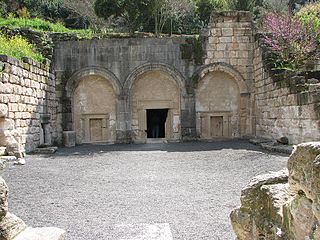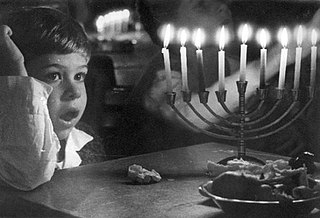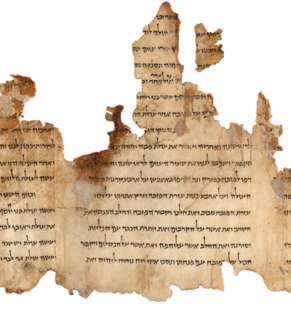
Judah ha-Nasi or Judah I, was a second-century rabbi and chief redactor and editor of the Mishnah. He lived from approximately 135 to 217 CE. He was a key leader of the Jewish community during the Roman occupation of Judea.

Simeon bar Yochai, also known by his acronym Rashbi, was a 2nd-century tannaitic sage in ancient Judea, said to be active after the destruction of the Second Temple in 70 CE. He was one of the most eminent disciples of Rabbi Akiva, and attributed by many Orthodox Jews with the authorship of the Zohar, the chief work of Kabbalah.

Hakham is a term in Judaism, meaning a wise or skillful man; it often refers to someone who is a great Torah scholar. It can also refer to any cultured and learned person: "He who says a wise thing is called a hakham, even if he be not a Jew." Hence in Talmudic-Midrashic literature, wise gentiles are commonly called hakme ummot ha-'olam.

Rabbi Meir or Rabbi Meir Baal HaNes was a Jewish sage who lived in the time of the Mishna. He was considered one of the greatest of the Tannaim of the fourth generation (139-163). He is the third most frequently mentioned sage in the Mishnah. His wife Bruriah is one of the few women cited in the Gemara.

Vayeshev, Vayeishev, or Vayesheb is the ninth weekly Torah portion in the annual Jewish cycle of Torah reading. The parashah constitutes Genesis 37:1–40:23. The parashah tells the stories of how Jacob's other sons sold Joseph into captivity in Egypt, how Judah wronged his daughter-in-law Tamar and discovered his transgression, and how Joseph served Potiphar and was imprisoned when falsely accused of assaulting Potiphar's wife.
Judah bar Ilai, also known as Yehuda bar Ma'arava and Rabbi Judah, was a rabbi of the 2nd century. Of the many Judahs in the Talmud, he is the one referred to simply as "Rabbi Judah" and is the most frequently mentioned sage in the Mishnah.

Shemini, Sh'mini, or Shmini is the 26th weekly Torah portion in the annual Jewish cycle of Torah reading and the third in the Book of Leviticus. Parashah Shemini tells of the consecration of the Tabernacle, the deaths of Nadab and Abihu, and the dietary laws of kashrut. The parashah constitutes Leviticus 9:1–11:47. It is made up of 4,670 Hebrew letters, 1,238 Hebrew words, 91 verses, and 157 lines in a Torah Scroll.
Demai (Hebrew: דְּמַאי, meaning "agricultural produce about which there is a doubt whether it has been properly tithed" is the third tractate of Seder Zeraim of the Mishnah and of the Talmud. It deals with the Jewish legal concept of demai, doubtfully tithed produce, and concerns the laws related to agricultural produce about which it is suspected that certain obligatory tithes have not been properly separated in accordance with requirements specified in the Torah. The tithes in question are ma'aser rishon, terumath ma'aser, and ma'aser sheni or ma'aser ani, depending on the year of the Sabbatical year cycle.

Naso or Nasso is the 35th weekly Torah portion in the annual Jewish cycle of Torah reading and the second in the Book of Numbers. It constitutes Numbers 4:21–7:89. The parashah addresses priestly duties, camp purification, restitution for wrongs committed, the wife accused of unfaithfulness, the nazirite, the Priestly Blessing, and consecration of the Tabernacle. Naso has the largest number of letters, words, and verses of any of the 54 weekly Torah portions. The parashah is made up of 8,632 Hebrew letters, 2,264 Hebrew words, and 176 verses, and can occupy about 311 lines in a Torah Scroll.
Eliezer ben Jose was a Jewish rabbi who lived in Judea in the 2nd century. He was the son of Jose the Galilean, and is regarded as a tanna of the fourth generation. He was a pupil of Rabbi Akiva.
Jose b. Abin was a Jewish Talmudist, known as an amora of the fifth generation who lived in the Galilee in the Land of Israel. He was the son of Rabban Abin I and the teacher of Abin II. He was at first the pupil of Rabbi Jose of Yodqart, but the latter's indifference to his own family caused Jose to leave him and follow Assi. Jose was the most important among the last Halakhists of the amoraim of the Land of Israel. He had a thorough knowledge not only of the Judean customs and halakhot, but of the Babylonian, a fact that has led some scholars to maintain that Jose must have resided at some time in Babylonia. It is probable, however, that he derived his knowledge of Babylonian teaching from his father, who had traveled in Babylonia.

V'Zot HaBerachah, VeZos HaBerachah, VeZot Haberakha, V'Zeis Habrocho, V'Zaus Haberocho, V'Zois Haberuchu, or Zos Habrocho is the 54th and final weekly Torah portion in the annual Jewish cycle of Torah reading and the 11th and last in the Book of Deuteronomy. It constitutes Deuteronomy 33:1–34:12. The parashah sets out the farewell Blessing of Moses for the 12 Tribes of Israel and concludes with the death of Moses.
Joshua ben Levi was an amora, a scholar of the Talmud, who lived in the Land of Israel in the first half of the third century. He lived and taught in the city of Lod. Rabbi Yehoshua was an elder contemporary of Johanan bar Nappaha and Resh Lakish, who presided over the school in Tiberias. With Johanan bar Nappaha, he often engaged in homiletic exegetical discussions.

Midrash Tadshe is a small midrash which begins with an interpretation of Gen. 1:11:
And God said, Let the earth bring forth". "Why," asked R. Phinehas, "did God decree that grass and herbs and fruits should grow upon the third day, while light was not created until the fourth? To show His infinite power, which is almighty; for even without the light He caused the earth to bring forth [while now He creates all manner of trees and plants through the operation of the light].
Hoshaiah Rabbah or Hoshayya Rabbah was Palestinian amora of the first amoraic generation, compiler of baraitot explaining the Mishnah-Tosefta. He was closely associated with the successors of Rebbi, as was his father with Rebbi himself. Hoshaiah's father, Ḥama, lived in Sepphoris, the residence of Rebbi and the seat of the patriarchs.
Abba Jose ben Hanan or Abba Jose ben Hanin was a tanna who lived in Judea during the 1st century CE. His career spanned the last decades before the destruction of the Second Temple and was a contemporary of Eliezer ben Jacob and of Hanina ben Antigonus, with both of whom he is mentioned in a halakhic discussion. His name occurs also as "Abba Jose ben Hanan," or "ben Johanan", "Abba Joseph," and"Abba Issi." Jose's halakot are also mentioned in Sifre, Numbers 8, Mid. ii. 6, and Sotah 20b. He transmitted an aggadah of Abba Kohen Bardela and one of Shmuel haKatan. A sentence of Jose's, rebuking the priestly families that acted violently toward the people, transmitted by Abba Saul ben Batnit, reads as follows: "Woe unto me for the house of Boethus and their rods; woe unto me for the house of Hanin and their calumnious whispering; woe unto me for the house of Qatros and their pens; woe unto me for the house of Ishmael ben Phabi and their fists."
Eleazar ha-Kappar was a Jewish rabbi of the fifth and last generation of the Tannaim era. He was a colleague of Judah haNasi, and was in the company of him occasionally. He spent most of his life at ancient Katzrin. He was the father of Bar Kappara, who is sometimes cited by the same name. He had a nephew named Hiyya, who was known for his pleasant voice.
Rabbi Hilkiah was an Amora of the Land of Israel of the fourth generation of the Amoraic era. He was an Aggadist and his articles mostly dealt with this issue.
Rav Jeremiah b. Abba was a second generation Jewish Babylonian Amora sage. He was the pupil of the famous Amora R. Abba Arika. He is cited many times in the Jerusalem Talmud, where he is mentioned simply as R. Jeremiah, without his patronymic name. Some are in the opinion that he was also called R. Jeremiah Rabbah.











